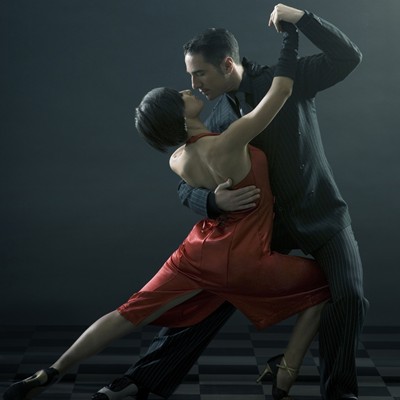I immediately realize he's right -- or at least that tango requires me to bring my meditation training to the dance. Just before his comment, I'd been looking over his shoulder at the pairs of students moving around the studio, shifting my attention off my partner and his guidance. Wrong move. Like bringing my awareness back to my breath in shamata meditation, I bring my attention back to Jack, the instructor, back to this moment, this step, this gentle pressure that his palm exerts against mine, telling my body to pivot left.
Tango lessons are nowhere on my bucket list, but I'm visiting a dear friend who's just started and asks if I want to go with her. I can take the intro class and stay for the beginner class, if I'm inclined. After that we can go practice at nearby sushi restaurant that lets the tango-ers take over a back room that's under-used in the late afternoon.
I'm neutral on the tango, personally, but I'm delighted by her delight and willing to explore its spark. I've no personal investment in this -- if I somehow am unable to perform the duties of tango, I can sit on the side and watch. I love to watch dance, to observe bodies in space.
Why the tango? the instructor asks the three couples and me who are there for the rank beginner intro class (my friend opts for the more advanced technique side of the room). I'm just here with a friend, I say. I'm open to whatever the experience is. (That's meditation practice right there -- going in without hope or fear, free from attachment and aversion.)
And if it is a meditation, the tango is tantric meditation -- at least as I hear it explained by this instructor. It's less about following a set pattern of steps and more about sensing and playing with energy, he says. The leader doesn't push his partner into steps but feels her energy and uses that to guide her. It's a movement of active and receptive energy, subtle and silent, sensed rather than announced. It requires concentration and relaxation, stillness and movement. There's a leader and follower -- male and female, for this class -- but those roles are fluid; the leader actually follows the follower's energy; the follower guides the leader, taking languid pauses for a flip of the heel or a circle on the floor.
Most of all, it requires presence, the willingness to be there with the energy and let it flow. Try to anticipate, and you block the movement. Look around and compare yourself to others and stumble. It's only fun if you're doing only it.
And it is fun -- to take those attention-gathering skills off the cushion and bring them to the dance, to use them with bodies in motion -- and in relationship, not just in stillness. (I confess: I love the prostration part of my ngondro practice because of the physicality, a rare time when the body in the body-speech-mind triad gets to move.)
And if meditation training applies to tango lessons, maybe there are other, less exotic places
where it also can bring vibrancy and delight and an awareness of energies interacting, giving and receiving, guiding and following. Maybe we can be like the Padma deities in the Dechen Barwa, "magical dancers ... in the boundless net of illusion."
Maybe enlightenment is being able to tango with reality. Backwards, sometimes. And in glittery high heels.



No comments:
Post a Comment